formerly eScholarship Editions


|
|
|
|
Your search for
'United States History' in subject
found 177 book(s). | Modify Search | Displaying 41 - 60 of 177 book(s) | |
| 41. | 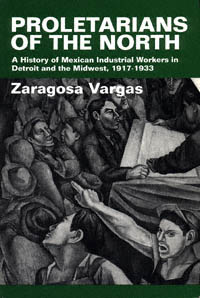 | Title: Proletarians of the North: a history of Mexican industrial workers in Detroit and the Midwest, 1917-1933 Author: Vargas, Zaragosa Published: University of California Press, 1993 Subjects: History | United States History | Latino Studies | Chicano Studies Publisher's Description: Between the end of World War I and the Great Depression, over 58,000 Mexicans journeyed to the Midwest in search of employment. Many found work in agriculture, but thousands more joined the growing ranks of the industrial proletariat. Throughout the northern Midwest, and especially in Detroit, Mexican workers entered steel mills, packing houses, and auto plants, becoming part of the modern American working class.Zaragosa Vargas's work focuses on this little-known feature in the history of Chicanos and American labor. In relating the experiences of Mexicans in workplace and neighborhood, and in showing the roles of Mexican women, the Catholic Church, and labor unions, Vargas enriches our knowledge of immigrant urban life. His is an important work that will be welcomed by historians of Chicano Studies and American labor. [brief] Similar Items |
| 42. | 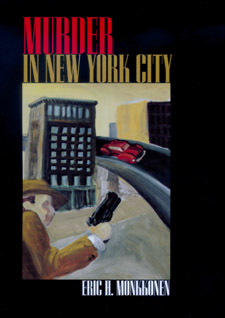 | Title: Murder in New York City Author: Monkkonen, Eric H 1942- Published: University of California Press, 2001 Subjects: American Studies | Psychology | Criminology | United States History Publisher's Description: Murder in New York City dramatically expands what we know about urban homicide, and challenges some of the things we think we know. Eric Monkkonen's unprecedented investigation covers two centuries of murder in America's biggest city, combining newly assembled statistical evidence with many other documentary sources to tease out the story behind the figures. As we generally believe, the last part of the twentieth century was unusually violent, but there have been other high-violence eras as well: the late 1920s and the mid-nineteenth century, the latter because the absence of high-quality weapons and ammunition makes that era's stabbings and beatings seem almost more vicious. Monkkonen's long view allows us to look back to a time when guns were rarer, when poverty was more widespread, and when racial discrimination was more intense, and to ask what difference these things made. With many vivid case studies for illustration, he examines the crucial factors in killing through the years: the weapons of choice, the sex and age of offenders and victims, the circumstances and settings in which homicide tends to occur, and the race and ethnicity of murderers and their victims. In a final chapter, Monkkonen looks to the international context and shows that New York - and, by extension, the United States - has had consistently higher violence levels than London and Liverpool. No single factor, he says, shapes this excessive violence, but exploring the variables of age, ethnicity, weapons, and demography over the long term can lead to hope of changing old patterns. [brief] Similar Items |
| 43. | 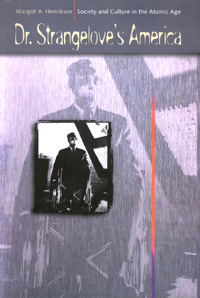 | Title: Dr. Strangelove's America: society and culture in the atomic age Author: Henriksen, Margot A Published: University of California Press, 1997 Subjects: History | United States History | Cultural Anthropology | Sociology Publisher's Description: Did America really learn to "stop worrying and love the bomb," as the title of Stanley Kubrick's 1964 film, Dr. Strangelove , would have us believe? Does that darkly satirical comedy have anything in common with Martin Luther King Jr.'s impassioned "I Have a Dream" speech or with Elvis Presley's throbbing "I'm All Shook Up"? In Margot Henriksen's vivid depiction of the decades after World War II, all three are expressions of a cultural revolution directly related to the atomic bomb. Although many scientists and other Americans protested the pursuit of nuclear superiority after World War II ended, they were drowned out by Cold War rhetoric that encouraged a "culture of consensus." Nonetheless, Henriksen says, a "culture of dissent" arose, and she traces this rebellion through all forms of popular culture.At first, artists expressed their anger, anxiety, and despair in familiar terms that addressed nuclear reality only indirectly. But Henriksen focuses primarily on new modes of expression that emerged, discussing the disturbing themes of film noir (with extended attention to Alfred Hitchcock) and science fiction films, Beat poetry, rock 'n' roll, and Pop Art. Black humor became a primary weapon in the cultural revolution while literature, movies, and music gave free rein to every possible expression of the generation gap. Cultural upheavals from "flower power" to the civil rights movement accentuated the failure of old values.Filled with fascinating examples of cultural responses to the Atomic Age, Henriksen's book is a must-read for anyone interested in the United States at mid-twentieth century. [brief] Similar Items |
| 44. | 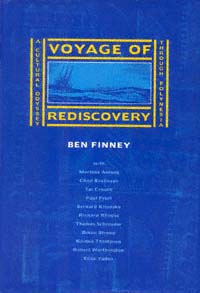 | Title: Voyage of rediscovery: a cultural odyssey through Polynesia Author: Finney, Ben R Published: University of California Press, 1994 Subjects: Anthropology | United States History | East Asia Other | Asian History Publisher's Description: In the summer of 1985, a mostly Hawaiian crew set out aboard Hokule'a, a reconstructed ancient double canoe, to demonstrate what skeptics had steadfastly denied: that their ancestors, sailing in such canoes and navigating solely by reading stars, ocean swells, and other natural signs, could intentionally have sailed across the Pacific, exploring the vast oceanic realm of Polynesia and discovering and settling all its inhabitable islands. Their round-trip odyssey from Hawai'i to Aotearoa (New Zealand), across 12,000 nautical miles, dramatically refuted all theories declaring that - because of their unseaworthy canoes and inaccurate navigational methods - the ancient Polynesians could only have been pushed accidentally to their islands by the vagaries of wind and current. Voyage of Rediscovery is a vivid, immensely readable account of this remarkable journey through the Pacific, including tales of a curiosity attack by sperm whales and the crew's welcome to Aotearoa by Maori tribesmen, who dubbed them their sixth tribe. It describes how Hawaiian navigator Nainoa Thompson guided the canoe over thousands of miles of open ocean without compass, sextant, charts, or any other navigational aids. In so doing, it documents the experimental voyaging approach, developed by Ben Finney, which has both transformed our ideas about Polynesian migration and voyaging and been embraced by present-day Polynesians as a way to experience and celebrate their rich ancestral heritage as premier seafarers.By sailing in the wake of their ancestors, the Hawaiians and other Polynesians who captained, navigated, and crewed Hokule'a made the journey described here a cultural as well as a scientific odyssey of exploration. [brief] Similar Items |
| 45. | 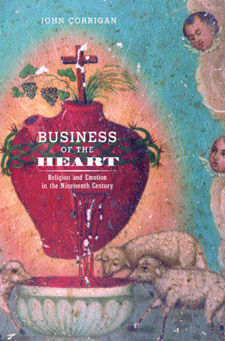 | Title: Business of the heart: religion and emotion in the nineteenth century Author: Corrigan, John 1952- Published: University of California Press, 2001 Subjects: Religion | American Studies | United States History | Christianity Publisher's Description: The "Businessmen's Revival" was a religious revival that unfolded in the wake of the 1857 market crash among white, middle-class Protestants. Delving into the religious history of Boston in the 1850s, John Corrigan gives an imaginative and wide-ranging interpretive study of the revival's significance. He uses it as a focal point for addressing a spectacular range of phenomena in American culture: the ecclesiastical and business history of Boston; gender roles and family life; the history of the theater and public spectacle; education; boyculture; and, especially, ideas about emotion during this period. This vividly written narrative recovers the emotional experiences of individuals from a wide array of little-used sources including diaries, correspondence, public records, and other materials. From these sources, Corrigan discovers that for these Protestants, the expression of emotion was a matter of transactions. They saw emotion as a commodity, and conceptualized relations between people, and between individuals and God, as transactions of emotion governed by contract. Religion became a business relation with God, with prayer as its legal tender. Entering this relationship, they were conducting the "business of the heart." This innovative study shows that the revival--with its commodification of emotional experience--became an occasion for white Protestants to underscore differences between themselves and others. The display of emotion was a primary indicator of membership in the Protestant majority, as much as language, skin color, or dress style. As Corrigan unravels the significance of these culturally constructed standards for emotional life, his book makes an important contribution to recent efforts to explore the links between religion and emotion, and is an important new chapter in the history of religion. [brief] Similar Items |
| 46. | 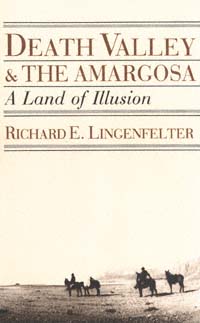 | Title: Death Valley & the Amargosa: a land of illusion Author: Lingenfelter, Richard E Published: University of California Press, 1988 Subjects: History | California and the West | United States History Similar Items |
| 47. |  | Title: Slide Mountain, or, The folly of owning nature Author: Steinberg, Theodore 1961- Published: University of California Press, 1995 Subjects: Law | Environmental Studies | United States History | American Studies Publisher's Description: The drive to own the natural world in twentieth-century America seems virtually limitless. Signs of this national penchant for possessing nature are everywhere - from suburban picket fences to elaborate schemes to own underground water, clouds, even the ocean floor.Yet, as Theodore Steinberg demonstrates in this compelling, witty look at Americans' attempts to master the environment, nature continually turns these efforts into folly. In a rich, narrative style recalling the work of John McPhee, Steinberg tours America to explore some of the more unusual dilemmas that have arisen in our struggle to possess nature.Beginning along the Missouri River, Steinberg recounts the battle for three thousand acres of land the river carved from a Nebraska Indian reservation and deposited in Iowa. Then he travels to Louisiana, where an army of lawyers butted heads over whether Six Mile Lake was actually a lake or a stream. He continues to Arizona to investigate who owned the underground, then to Pennsylvania's Blue Ridge Mountains to see who claimed the clouds. He ends in crowded New York City with Donald Trump's struggle for air rights.Americans' obsession with owning nature was immortalized by Mark Twain in the tale of Slide Mountain, where a landslide-prone Nevada peak turned the American dream of real estate into dust. In relating these modern-day "Slide Mountain" stories, Steinberg illuminates what it means to live in a culture of property where everything must have an owner. [brief] Similar Items |
| 48. | 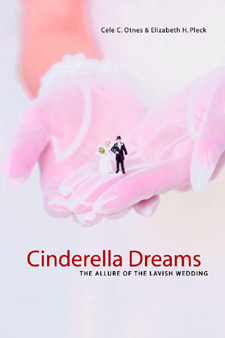 | Title: Cinderella dreams: the allure of the lavish wedding Author: Otnes, Cele Published: University of California Press, 2003 Subjects: Sociology | Anthropology | Women's Studies | Consumerism | United States History Publisher's Description: The fabulous gown, the multitiered cake, abundant flowers, attendants and guests in their finery. The white wedding does more than mark a life passage. It marries two of the most sacred tenets of American culture - romantic love and excessive consumption. For anyone who has ever wondered about the meanings behind a white dress, a diamond ring, rice, and traditions such as cake cutting, bouquet tossing, and honeymooning, this book offers an entertaining and enlightening look at the historical, social, and psychological strains that come together to make the lavish wedding the most important cultural ritual in contemporary consumer culture. With an emphasis on North American society, Cele C. Otnes and Elizabeth H. Pleck show how the elaborate wedding means far more than a mere triumph for the bridal industry. Through interviews, media accounts, and wide-ranging research and analysis, they expose the wedding's reflection - or reproduction - of fundamental aspects of popular consumer culture: its link with romantic love, its promise of magical transformation, its engendering of memories, and its legitimization of consumption as an expression of perfection. As meaningful as any prospective bride might wish, the lavish wedding emerges here as a lens that at once reveals, magnifies, and reveres some of the dearest wishes and darkest impulses at the heart of our culture. [brief] Similar Items |
| 49. | 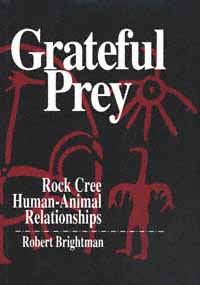 | Title: Grateful prey: Rock Cree human-animal relationships Author: Brightman, Robert Alain 1950- Published: University of California Press, 1993 Subjects: Anthropology | Anthropology | United States History | Religion Publisher's Description: The interaction between religious beliefs and hunting practices among the Asiniskawidiniwak or Rock Crees of northern Manitoba is the focus of Robert Brightman's detailed study. This foraging society, he says, bases aspects of its hunting and trapping largely on what we call "religious" conceptions.Seeking an ideology, however, that incorporates Cree beliefs about human-animal differences and the relationships that should exist between them as hunter and prey, Brightman finds these beliefs to be disordered and unstable rather than systematic. Animals are represented as simultaneously more and less powerful than humans. The hunter-prey relationship is talked about as both collaborative and adversarial. Exploring the influence of these religious representations on technical aspects of subsistence historically, Brightman finds that Crees' attitudes and actions toward animals were, and are, relatively arbitrary with respect to biological and environmental forces. Anthropologists will see in his well-researched discussion a challenge to prevailing ecological and Marxist approaches to foraging societies. [brief] Similar Items |
| 50. | 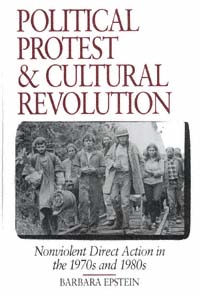 | Title: Political protest and cultural revolution: nonviolent direct action in the 1970s and 1980s Author: Epstein, Barbara Published: University of California Press, 1991 Subjects: History | Politics | American Studies | United States History | Sociology Publisher's Description: From her perspective as both participant and observer, Barbara Epstein examines the nonviolent direct action movement which, inspired by the civil rights movement, flourished in the United States from the mid-seventies to the mid-eighties. Disenchanted with the politics of both the mainstream and the organized left, and deeply committed to forging communities based on shared values, activists in this movement developed a fresh, philosophy and style of politics that shaped the thinking of a new generation of activists. Driven by a vision of an ecologically balanced, nonviolent, egalitarian society, they engaged in political action through affinity groups, made decisions by consensus, and practiced mass civil disobedience.The nonviolent direct action movement galvanized originally in opposition to nuclear power, with the Clamshell Alliance in New England and then the Abalone Alliance in California leading the way. Its influence soon spread to other activist movements - for peace, non-intervention, ecological preservation, feminism, and gay and lesbian rights.Epstein joined the San Francisco Bay Area's Livermore Action Group to protest the arms race and found herself in jail along with a thousand other activists for blocking the road in front of the Lawrence Livermore Laboratory. She argues that to gain a real understanding of the direct action movement it is necessary to view it from the inside. For with its aim to base society as a whole on principles of egalitarianism and nonviolence, the movement sought to turn political protest into cultural revolution. [brief] Similar Items |
| 51. | 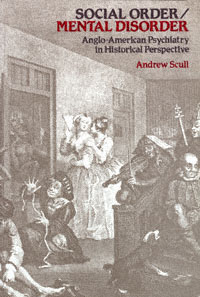 | Title: Social order/mental disorder: Anglo-American psychiatry in historical perspective Author: Scull, Andrew T Published: University of California Press, 1989 Subjects: Sociology | Psychiatry | United States History | European History | Psychology Similar Items |
| 52. |  | Title: The Antislavery debate: capitalism and abolitionism as a problem in historical interpretation Author: Bender, Thomas Published: University of California Press, 1992 Subjects: History | United States History | American Studies Publisher's Description: This volume brings together one of the most provocative debates among historians in recent years. The center of controversy is the emergence of the antislavery movement in the United States and Britain and the relation of capitalism to this development.The essays delve beyond these issues, however, to raise a deeper question of historical interpretation: What are the relations between consciousness, moral action, and social change? The debate illustrates that concepts common in historical practice are not so stable as we have thought them to be. It is about concepts as much as evidence, about the need for clarity in using the tools of contemporary historical practice.The participating historians are scholars of great distinction. Beginning with an essay published in the American Historical Review ( AHR ), Thomas L. Haskell challenged the interpretive framework of David Brion Davis's celebrated study, The Problem of Slavery in the Age of Revolution . The AHR subsequently published responses by Davis and by John Ashworth, as well as a rejoinder by Haskell. The AHR essays and the relevant portions of Davis's book are reprinted here. In addition, there are two new essays by Davis and Ashworth and a general consideration of the subject by Thomas Bender.This is a highly disciplined, insightful presentation of a major controversy in historical interpretation that will expand the debate into new realms. [brief] Similar Items |
| 53. | 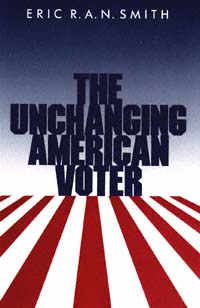 | Title: The unchanging American voter Author: Smith, Eric R. A. N Published: University of California Press, 1989 Subjects: Politics | United States History | American Studies Publisher's Description: Have the American people grown more politically sophisticated in the past three decades, or do they remain relatively ignorant of the political world? Did a "great leap forward" take place during the 1960s in which our citizenry became involved and adept voters? In this important book, Eric Smith addresses these and other provocative questions that have long befuddled political scientists and policymakers.Much of the current wisdom about American voters derives from an argument advanced in a volume entitled The Changing American Voter , written by Nie, Verba, and Petrocik. In this work, the authors contend that the electorate made a "great leap forward" in political sophistication and ideological thinking between the 1960 and 1964 elections. They argue that people changed in response to a shifting environment, and that, in particular, the surge of protest and ideological rhetoric between 1960 and 1964 engendered a new political savvy and sophistication. In their view, people learned to understand politics better, to relate the issues to the candidates more accurately, and to cast more informed, intelligent votes.In The Unchanging American Voter , Smith takes issue with this portrait of an engaged American citizenry and replaces it with a quite different picture of the voters of this nation. He posits a more bleak political l andscape in which the typical voter knows little about politics, is not interested in the political arena and consequently does not participate in it, and is even unable to organize his or her attitudes in a coherent manner. To support this view, Smith demonstrates how the indices by which Nie, Verba, and Petrocik measured levels of sophistication during the 1960s were methodologically flawed and how a closer examination of supposed changes reveals only superficial and unimportant shifts in the ways voters have approached the ballot box since the 1950s. The Unchanging American Voter is an intelligent and original work that provides a new perspective of the American citizenry. It is sure to engender discussion and debate about the dynamics of voting in postwar America. [brief] Similar Items |
| 54. | 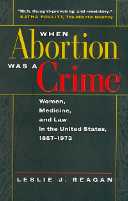 | Title: When abortion was a crime: women, medicine, and law in the United States, 1867-1973 Author: Reagan, Leslie J Published: University of California Press, 1997 Subjects: History | Women's Studies | United States History | Medicine Publisher's Description: As we approach the 30th anniversary of Roe v. Wade , it's crucial to look back to the time when abortion was illegal. Leslie Reagan traces the practice and policing of abortion, which although illegal was nonetheless widely available, but always with threats for both doctor and patient. In a time when many young women don't even know that there was a period when abortion was a crime, this work offers chilling and vital lessons of importance to everyone.The linking of the words "abortion" and "crime" emphasizes the difficult and painful history that is the focus of Leslie J. Reagan's important book. Her study is the first to examine the entire period during which abortion was illegal in the United States, beginning in the mid-nineteenth century and ending with Roe v. Wade in 1973. Although illegal, millions of abortions were provided during these years to women of every class, race, and marital status. The experiences and perspectives of these women, as well as their physicians and midwives, are movingly portrayed here.Reagan traces the practice and policing of abortion. While abortions have been typically portrayed as grim "back alley" operations, she finds that abortion providers often practiced openly and safely. Moreover, numerous physicians performed abortions, despite prohibitions by the state and the American Medical Association. Women often found cooperative practioners, but prosecution, public humiliation, loss of privacy, and inferior medical care were a constant threat.Reagan's analysis of previously untapped sources, including inquest records and trial transcripts, shows the fragility of patient rights and raises provocative questions about the relationship between medicine and law. With the right to abortion again under attack in the United States, this book offers vital lessons for every American concerned with health care, civil liberties, and personal and sexual freedom. [brief] Similar Items |
| 55. | 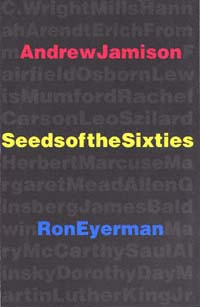 | Title: Seeds of the sixties Author: Jamison, Andrew Published: University of California Press, 1994 Subjects: History | United States History | American Studies | Social Theory Publisher's Description: "The Sixties." The powerful images conveyed by those two words have become an enduring part of American cultural and political history. But where did Sixties radicalism come from? Who planted the intellectual seeds that brought it into being? These questions are answered with striking clarity in Andrew Jamison and Ron Eyerman's book. The result is a combination of history and biography that vividly portrays an entire culture in transition.The authors focus on specific individuals, each of whom in his or her distinctive way carried the ideas of the 1930s into the decades after World War II, and each of whom shared in inventing a new kind of intellectual partisanship. They begin with C. Wright Mills, Hannah Arendt, and Erich Fromm and show how their work linked the "old left" of the Thirties to the "new left" of the Sixties. Lewis Mumford, Rachel Carson, and Fairfield Osborn laid the groundwork for environmental activism; Herbert Marcuse, Margaret Mead, and Leo Szilard articulated opposition to the postwar "scientific-technological state." Alternatives to mass culture were proposed by Allen Ginsberg, James Baldwin, and Mary McCarthy; and Saul Alinsky, Dorothy Day, and Martin Luther King, Jr., made politics personal.This is an unusual book, written with an intimacy that brings to life both intellect and emotion. The portraits featured here clearly demonstrate that the transforming radicalism of the Sixties grew from the legacy of an earlier generation of thinkers. With a deep awareness of the historical trends in American culture, the authors show us the continuing relevance these partisan intellectuals have for our own age. "In a time colored by 'political correctness' and the ascendancy of market liberalism, it is well to remember the partisan intellectuals of the 1950s. They took sides and dissented without becoming dogmatic. May we be able to say the same about ourselves." - from Chapter 7 [brief] Similar Items |
| 56. |  | Title: Emigrants and society: Extremadura and America in the sixteenth century Author: Altman, Ida Published: University of California Press, 1989 Subjects: History | European History | United States History Publisher's Description: The opening of the New World to Spanish settlement had more than the limited impact on individuals and society which scholars have traditionally granted it. Many families and young single people left the neighboring cities of Cáceres and Trujillo in the Extremadura region of southwestern Spain for the Indies. By maintaining ties with home and one another, and sometimes returning, these emigrants developed patterns of involvement that on one level were linked directly to place of origin and on another would come to characterize the emigration movement as a whole. Ida Altman shows that the Indies could and did have a substantial and perceptible effect on local society in Spain, as the New World quickly became an important arena of activity for people seeking new and better opportunities. Her findings suggest interesting conclusions regarding the relationship of sixteenth-century Spanish emigration to the larger movement of people from Europe to the Western Hemisphere in modern times. [brief] Similar Items |
| 57. | 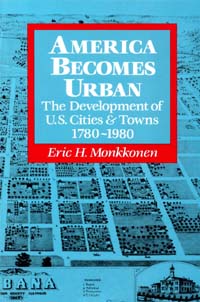 | Title: America becomes urban: the development of U.S. cities & towns, 1780-1980 Author: Monkkonen, Eric H 1942- Published: University of California Press, 1988 Subjects: History | United States History | Urban Studies Publisher's Description: America's cities: celebrated by poets, courted by politicians, castigated by social reformers. In their numbers and complexity they challenge comprehension. Why is urban America the way it is? Eric Monkkonen offers a fresh approach to the myths and the history of US urban development, giving us an unexpected and welcome sense of our urban origins. His historically anchored vision of our cities places topics of finance, housing, social mobility, transportation, crime, planning, and growth into a perspective which explains the present in terms of the past and ofers a point from which to plan for the future. [brief] Similar Items |
| 58. | 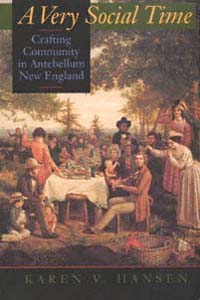 | Title: A very social time: crafting community in antebellum New England Author: Hansen, Karen V Published: University of California Press, 1994 Subjects: History | United States History | Gender Studies | Social Theory Publisher's Description: Karen Hansen's richly anecdotal narrative explores the textured community lives of New England's working women and men - both white and black - n the half century before the Civil War. Her use of diaries, letters, and autobiographies brings their voices to life, making this study an extraordinary combination of historical research and sociological interpretation.Hansen challenges conventional notions that women were largely relegated to a private realm and men to a public one. A third dimension - the social sphere - also existed and was a critical meeting ground for both genders. In the social worlds of love, livelihood, gossip, friendship, and mutual assistance, working people crossed ideological gender boundaries.The book's rare collection of original writings reinforces Hansen's arguments and also provides an intimate glimpse into antebellum New England life. [brief] Similar Items |
| 59. | 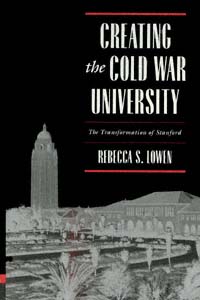 | Title: Creating the Cold War university: the transformation of Stanford Author: Lowen, Rebecca S 1959- Published: University of California Press, 1997 Subjects: History | Education | Technology and Society | Military History | Californian and Western History | History and Philosophy of Science | California and the West | Intellectual History | United States History | United States History Publisher's Description: The "cold war university" is the academic component of the military-industrial-academic complex, and its archetype, according to Rebecca Lowen, is Stanford University. Her book challenges the conventional wisdom that the post-World War II "multiversity" was created by military patrons on the one hand and academic scientists on the other and points instead to the crucial role played by university administrators in making their universities dependent upon military, foundation, and industrial patronage.Contesting the view that the "federal grant university" originated with the outpouring of federal support for science after the war, Lowen shows how the Depression had put financial pressure on universities and pushed administrators to seek new modes of funding. She also details the ways that Stanford administrators transformed their institution to attract patronage.With the end of the cold war and the tightening of federal budgets, universities again face pressures not unlike those of the 1930s. Lowen's analysis of how the university became dependent on the State is essential reading for anyone concerned about the future of higher education in the post-cold war era. [brief] Similar Items |
| 60. | 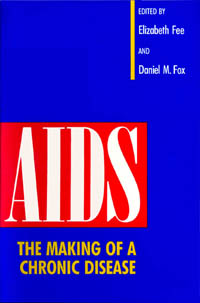 | Title: AIDS: the making of a chronic disease Author: Fee, Elizabeth Published: University of California Press, 1991 Subjects: History | Medicine | United States History | Sociology Publisher's Description: When AIDS was first recognized in 1981, most experts believed that it was a plague, a virulent unexpected disease. They thought AIDS, as a plague, would resemble the great epidemics of the past: it would be devastating but would soon subside, perhaps never to return. By the middle 1980s, however, it became increasingly clear that AIDS was a chronic infection, not a classic plague.In this follow-up to AIDS: The Burdens of History , editors Elizabeth Fee and Daniel M. Fox present essays that describe how AIDS has come to be regarded as a chronic disease. Representing diverse fields and professions, the twenty-three contributors to this work use historical methods to analyze politics and public policy, human rights issues, and the changing populations with HIV infection. They examine the federal government's testing of drugs for cancer and HIV, and show how the policy makers' choice of a specific historical model (chronic disease versus plague) affected their decisions. A powerful photo essay reveals the strengths of women from various backgrounds and lifestyles who are coping with HIV. A sensitive account of the complex relationships of the gay community to AIDS is included. Finally, several contributors provide a sampling of international perspectives on the impact of AIDS in other nations. [brief] Similar Items |